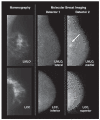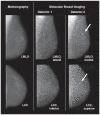Molecular breast imaging: use of a dual-head dedicated gamma camera to detect small breast tumors
- PMID: 19020253
- PMCID: PMC3885170
- DOI: 10.2214/AJR.07.3693
Molecular breast imaging: use of a dual-head dedicated gamma camera to detect small breast tumors
Abstract
Objective: Molecular breast imaging with a single-head cadmium zinc telluride (CZT) gamma camera has previously been shown to have good sensitivity for the detection of small lesions. To further improve sensitivity, we developed a dual-head molecular breast imaging system using two CZT detectors to simultaneously acquire opposing breast views and reduce lesion-to-detector distance. We determined the incremental gain in sensitivity of molecular breast imaging with dual detectors.
Subjects and methods: Patients with BI-RADS category 4 or 5 lesions < 2 cm that were identified on mammography or sonography and scheduled for biopsy underwent molecular breast imaging as follows: After injection of 740 MBq of technetium-99m ((99m)Tc) sestamibi, 10-minute craniocaudal and mediolateral oblique views of each breast were acquired. Blinded reviews were performed using images from both detectors 1 and 2 and images from detector 1 only (simulating a single-head system). Lesions were scored on a scale of 1-5; 2 or higher was considered positive.
Results: Of the 150 patients in the study, 128 cancers were confirmed in 88 patients. Averaging the results from the three blinded readers, the sensitivity of dual-head molecular breast imaging was 90% (115/128), whereas the sensitivity from review of only single-head molecular breast imaging was 80% (102/128). The sensitivity for the detection of cancers < or = 10 mm in diameter was 82% (50/61) for dual-head molecular breast imaging and 68% (41/61) for single-head molecular breast imaging. On average, 13 additional cancers were seen on dual-head images and the tumor uptake score increased by 1 or more in 60% of the identified tumors.
Conclusion: Gains in sensitivity with the dual-head system molecular breast imaging are partially due to increased confidence in lesion detection. Molecular breast imaging can reliably detect breast lesions < 2 cm and dual-head molecular breast imaging can significantly increase sensitivity for subcentimeter lesions.
Figures





References
-
- Kerlikowske K, Grady D, Rubin SM, Sandrock C, Ernster VL. Efficacy of screening mammography: a meta-analysis. JAMA. 1995;273:149–154. - PubMed
-
- Tabar L, Vitak B, Chen HH, Yen MF, Duffy SW, Smith RA. Beyond randomized controlled trials: organized mammographic screening substantially reduces breast carcinoma mortality. Cancer. 2001;91:1724–1731. - PubMed
-
- Kolb TM, Lichy J, Newhouse JH. Comparison of the performance of screening mammography, physical examination, and breast US and evaluation of factors that influence them: an analysis of 27,825 patient evaluations. Radiology. 2002;225:165–175. - PubMed
-
- Boyd NF, Guo H, Martin LJ, et al. Mammographic density and the risk and detection of breast cancer. N Engl J Med. 2007;356:227–236. - PubMed
Publication types
MeSH terms
Substances
Grants and funding
LinkOut - more resources
Full Text Sources
Other Literature Sources
Medical

